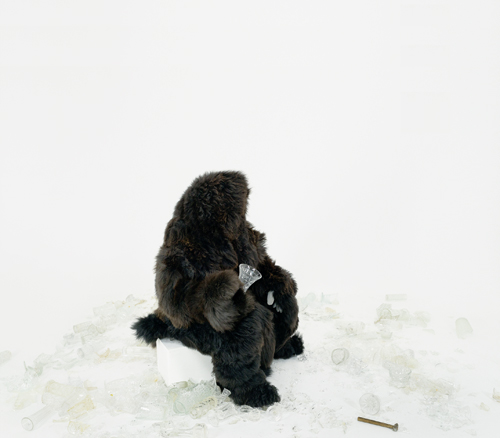Anca Munteanu Rimnic
Charim Events
Charim Events

For her first solo exhibition in Vienna, Anca Munteanu Rimnic presented a selection of works from the past five years. Her show at Charim Events was accompanied by the publication of a monograph with two essays, one addressing Munteanu Rimnic’s focus on loss and imperfection, the other discussing her specific approach to history. This approach is ‘indirect or deferred’, writes art historian John C. Welchman. Munteanu Rimnic’s interest focuses on the formal language brought forth by ‘specific times and events’.
The artist’s background – as a child, she came to Germany from Romania with her parents – plays an equally central role in her choice of formal idiom as well as art histo-rical references, such as to the history of late modernism. For the show’s newest work, Untitled (2015), Munteanu Rimnic transferred the abstract geometrical patterns of Romanian kelims to outsize jigsaw pieces in white ceramics. The process of symbolically obliterating an identifiable tradition (from specific local motifs to the neutral white of modernism) recalls Robert Rauschenberg’s Erased de Kooning Drawing (1953) for which Rauschenberg literally rubbed out a drawing by de Kooning. In Munteanu Rimnic’s work, however, the passing of a specific tradition (as Rauschenberg’s drawing announced a radical departure from Abstract Expressionism) is linked with her own biography. The erasure of colour in connection with the movable jigsaw pieces can thus be understood as a search for an identity, while the original context literally fades.
The five photographs in the series 5 x Peasants from (2013) have an identical theme. Found pictures of people in Romanian regional costume were photographed by the artist in such a way that the lighting turns their faces into white patches, robbing those portrayed of their individuality. Although this direct reference to the issue of identity is less subtle than the detour via traditional crafts, it also takes specific forms and motifs and links them to a specific cultural context. Less convincing were works in which engagements with tradition and folklore were reduced to objects and events that can no longer be culturally localized. The bronze sculpture of a wooden rod recalling a shepherd’s crook (Untitled, 2013), for example, that leaned casually in the corner of a room like André Cadere’s Barres de bois rond (1970–78), came across as a mere play on existing forms and surfaces.
In I never made a mistake (2014), on the other hand, Munteanu Rimnic skilfully allies the surface qualities of her materials with the work’s content. On rough, almost fabric-like handmade paper, she embossed the words ‘Ich habe nie einen Fehler gemacht’ (German for the work’s title). This is a quote from the artist’s mother that seems to assert the correctness of her decision to leave Romania. In small, almost illegible type, however, her words almost disappear on the large sheet of paper, losing their persuasive power. This play on dimensions reveals a certain humour seen elsewhere in the show mainly in the video Lament V – Reason (2013). The artist commissioned six Romanian funeral wailers to sing a lament based on the words ‘museum, curator, collector’ and culminating in a pained scream against the interdependencies of today’s art business. This work reflects a different take on tradition: here, instead of exploring the formal vocabulary of Romanian crafts and folklore, Munteanu Rimnic approaches tradition in the sense of a lived culture, using burial rituals to formulate a commentary on the reality of her own life.
Translated by Nicholas Grindell
















